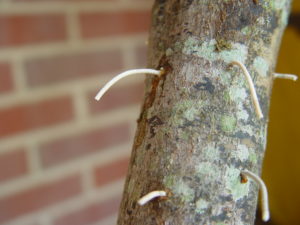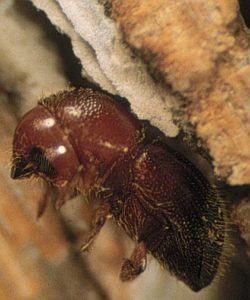
Granulate ambrosia beetle frass on red maple (Photo by Dr. Frank Hale, Univ. of Tenn. Extension Entomologist)

Granulate ambrosia beetle adult female (Photo by Dr. Frank Hale, Univ. of Tenn. Extension Entomologist)
Laurel wilt (Raffaelea lauricola) is an invasive deadly vascular wilt disease of red bay laurel and other trees in the Lauraceae family. The fungal disease is carried from tree to tree by a small beetle called the redbay ambrosia beetle (Xyleborus glabratus). This Ambrosia beetle bores into the wood and the fungus disease infects the tree. It is possible(?) that granulate ambrosia beetles may also transmit the disease. The disease spreads attacks the tree’s vascular system, blocking movement of water within, and the tree wilts and dies weeks or months later.
Key symptoms are beetle holes and frass tubes in the trunk of susceptible trees. Redbay ambrosia beetle is originally from southeastern Asia. Here is another example of how an Asiatic pest and fungus disease can be transported thousands of miles. It was likely introduced in wood products shipped from overseas.
Only plants in the Laurel family are susceptible to laurel wilt. The most severely affected species is redbay, which is a medium sized tree commonly found throughout the eastern part of the state. Sassafras (S. albidum), avocado, and spicebush (Lindera benzoin) are susceptible species, while mountain-laurel (Kalmia latifolia), rhododendrons, and sweetbay magnolia (M. virginiana) are not susceptible. So far, since 2011, Laurel wilt has been detected in North Carolina, Georgia, Mississippi, Alabama, Florida, South Carolina, Louisiana, Texas, and Arkansas.
About redbay ambrosia beetles
Female ambrosia beetles can fly and the males cannot. A single female beetle flies to a host tree, reproduces, and starts a new brood without mating. They’re wood borers and tunnel deep within the host trees.
The insect is tiny cylindrical brown to black beetle, about 1/16th inch long. Multiple generations of beetles are produced from late June through September. When you observe small “toothpicks” of sawdust and beetle excrement, called “frass”, form at ambrosia beetles entrance holes; beetles push materials out to create living space within the tree.
Management:
Currently, there is no effective control for this disease. Spraying the trunk of susceptible species with insecticides containing bifenthrin or permethrin in early spring can protect the tree from the beetle. Monitor this pest and and do not transport potentially-infested firewood. Insecticides are not totally effective in stopping beetle attacks. Fungicides are costly and must be re-applied annually. Properly disposed of diseased trees on site by burying or burning dead trees.


 Posted in
Posted in 
